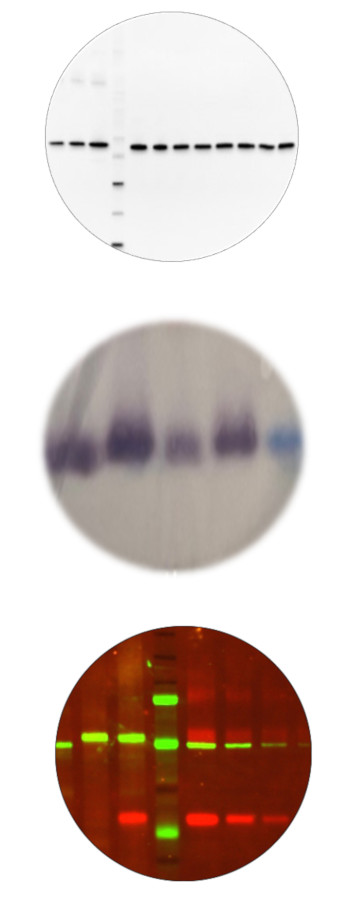Signal detectionChemiluminescent detectionIt is based on visualization of the activity of HRP (Horse Radish Peroxidase enzyme), coupled to the secondary antibody, using chemiluminescent detection reagents like for example Agrisera ECL reagents: Chromogenic detectionFor laboratories which do not have a CCD camera, visualization of the target protein can be made using so-called chromogenic detection using Agrisera BCIP/NBT ALP Substrate (AS19 BCIP-NBT) or Agrisera BCIP/NBT Plus ALP Substrate solution (AS19 BCIP-NBT-PLUS). In such a case, the secondary antibody is conjugated to an enzyme called ALP (Alkaline Phosphatase). The reaction is visualized directly on the membrane through color development, and the membrane can be stored in the lab book for a future reference. This detection system is not appropriate for proteins of low expression or to detect protein modifications, as phosphorylation. Fluorescent detectionFluorescent detection employs secondary antibody conjugated to a fluorescent dye, which will absorb light at a given wavelength and emit light of a higher wavelength, and does not involve use of any detection reagents. The fluorescent signal is recorded by a CCD camera. The advantage of this method is that it allows multiplexing more than one antibody per assay, and detection of normalization and loading controls on the same blot. Agrisera offers a wide range of secondary antibodies, conjugated to fluorescent dye, which can be used for signal visualization. The complete collection of Agrisera's secondary antibodies can be found here. |
|
Latest
Which isotype is a rabbit polyclonal antibody?2024-05-06 Why bands on the blot are not distinct from each other?
2024-05-02 What parameters should be consider when transferring HMW proteins?
2024-03-01 Why some antibodies have a broad species reactivity, while the others do not?
2024-02-20 Are directly conjugated primary antibodies always the best choice?
2023-12-28 How to obtain sharper protein bands in Western blot?
2023-12-20 Are monoclonal antibodies better, compared to polyclonal antibodies?
2023-11-30 Why, to detect some proteins, 6M urea must be included in the extraction and loading buffers?
2023-09-01 I have not used this antibody before, what conditions of Western blot do you recommend?
2023-07-27 Which subclasses of immunoglobulin G are found in rabbit serum?
2023-07-18
Archive
- May - 2024
- March - 2024
- February - 2024
- December - 2023
- November - 2023
- September - 2023
- July - 2023
- May - 2023
- March - 2023
- January - 2023
- December - 2022
- November - 2022
- October - 2022
- September - 2022
- August - 2022
- June - 2022
- May - 2022
- March - 2022
- February - 2022
- January - 2022
- November - 2021
- October - 2021
- August - 2021
- June - 2021
- May - 2021
- April - 2021
- March - 2021
- February - 2021
- January - 2021
- December - 2020
- November - 2020
- October - 2020
- September - 2020
- August - 2020
- July - 2020
- June - 2020
- May - 2020
- April - 2020
- March - 2020
- January - 2020
- November - 2019
- October - 2019
- March - 2019
- April - 2017
- February - 2017
- May - 2016
- February - 2014
- September - 2013
- December - 2010

